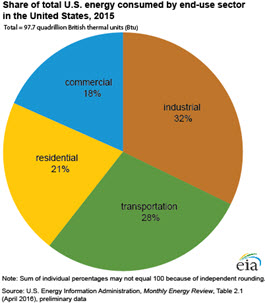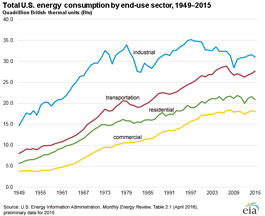How the United States uses energy
The United States is a highly developed and industrialized society. Americans use a lot of energy in homes, in businesses, and in industry. Americans also use energy for personal travel and for transporting goods. There are five energy consuming sectors:
- The industrial sector includes facilities and equipment used for manufacturing, agriculture, mining, and construction.
- The transportation sector includes vehicles that transport people or goods, such as cars, trucks, buses, motorcycles, trains, aircraft, boats, barges, and ships.
- The residential sector consists of homes and apartments.
- The commercial sector includes offices, malls, stores, schools, hospitals, hotels, warehouses, restaurants, and places of worship and public assembly.
- The electric power sector consumes primary energy to generate most of the electricity consumed by the other four sectors.
Each sector consumes primary energy. The industrial, transportation, residential, and commercial sectors also use most of the electricity (a secondary energy source) the electric power sector produces. They are called end-use sectors because they purchase or produce energy for their own consumption and not for resale.
Energy consumption in the United States was three times greater in 2015 than it was in 1949. In all but 19 of the years between 1949 and 2015, energy consumption increased over the previous year.
In 2009, this historical trend changed sharply because of the economic recession. In 2009, real gross domestic product (GDP) fell 2.8% compared to 2008, and total energy consumption decreased by nearly 5%, the largest single-year decreases in both real GDP and in total energy consumption from 1949 through 2015. Decreases in energy consumption occurred in all four major end-use sectors in 2009 (residential—3%, commercial—3%, industrial—9%, and transportation—3%). Consumption increased by about 4% in 2010, then decreased slightly in 2011 and decreased again by about 2% in 2012. In 2013, consumption increased by about 3% and increased by 1% in 2014. Consumption decreased by about 1% in 2015. Economic growth and other factors like weather and fuel prices influence consumption in each sector differently.





